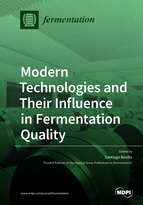Modern Technologies and Their Influence in Fermentation Quality
A special issue of Fermentation (ISSN 2311-5637). This special issue belongs to the section "Fermentation Process Design".
Deadline for manuscript submissions: closed (30 June 2019) | Viewed by 97613
Special Issue Editor
Special Issue Information
Dear Colleagues,
During the last few years, industrial fermentation technologies have advanced in order to improve the quality of the final product. Some examples of those modern technologies are the biotechnology developments of microbial materials, such as Saccharomyces and non-Saccharomyces yeasts or lactic bacteria from different genera. Other technologies are related to the use of additives and adjuvants, such as nutrients, enzymes, fining agents, or preservatives and their management, which directly influence the quality and reduce the risks in final fermentation products. Other technologies are based on the management of thermal treatments, filtrations, pressure applications, ultrasounds, UV, and so on, which have also led to improvements in fermentation quality in recent years.
The aim of the issue is to study new technologies able to improve the quality parameters of fermentation products, such as aroma, color, turbidity, acidity, or any other parameters related to improving sensory perception by the consumers. Food safety parameters are also included.
Prof. Dr. Santiago Benito
Guest Editor
Manuscript Submission Information
Manuscripts should be submitted online at www.mdpi.com by registering and logging in to this website. Once you are registered, click here to go to the submission form. Manuscripts can be submitted until the deadline. All submissions that pass pre-check are peer-reviewed. Accepted papers will be published continuously in the journal (as soon as accepted) and will be listed together on the special issue website. Research articles, review articles as well as short communications are invited. For planned papers, a title and short abstract (about 100 words) can be sent to the Editorial Office for announcement on this website.
Submitted manuscripts should not have been published previously, nor be under consideration for publication elsewhere (except conference proceedings papers). All manuscripts are thoroughly refereed through a single-blind peer-review process. A guide for authors and other relevant information for submission of manuscripts is available on the Instructions for Authors page. Fermentation is an international peer-reviewed open access monthly journal published by MDPI.
Please visit the Instructions for Authors page before submitting a manuscript. The Article Processing Charge (APC) for publication in this open access journal is 2600 CHF (Swiss Francs). Submitted papers should be well formatted and use good English. Authors may use MDPI's English editing service prior to publication or during author revisions.
Keywords
- Saccharomyces
- non-Saccharomyces
- lactic acid bacteria
- fermentation technology
- color
- aroma
- acidity
- quality parameters
- fermentation
- food safety






